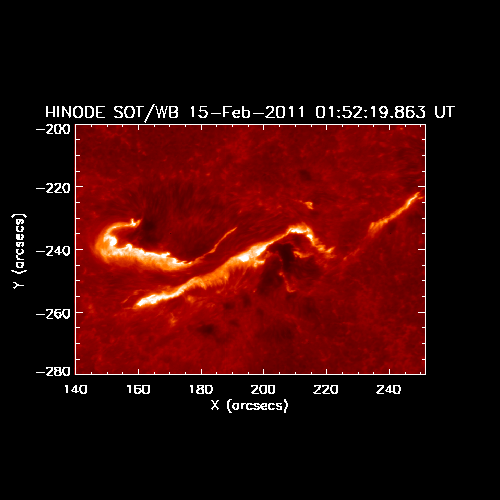Dr. Lyndsay Fletcher (University of Glasgow, UK) reports on flare ribbons, caused by the intense heating produced by energy released from the coronal magnetic field during solar flares.
 Flare ribbons observed by the Hinode Broadband Filter Imager on 15 February 2011.
Flare ribbons observed by the Hinode Broadband Filter Imager on 15 February 2011.
When energy is released from the coronal magnetic field during a solar flare, a large fraction of it ends up in the Sun's lower atmosphere - primarily the chromosphere, but also the photosphere. This results in intense, localised heating that produces an elongated pattern known as flare ribbons.
Ribbons can be tens of thousands of kilometres long, but at their narrowest are less than a hundred kilometres wide. Usually a pair of ribbons forms, one in positive magnetic field and the other in negative, and they separate as the flare proceeds. This is strong evidence that magnetic reconnection is at the heart of a flare; magnetic flux joining the corona and chromosphere is energised in turn, leading to the ribbon's sequential brightenings as the field is continually drawn into a coronal reconnection region.
Ribbons thus map out where the flare energy comes from and where it goes, and provide the link to magnetic evolution. The European Solar Telescope will be able to measure the speed, direction and brightness of the ribbons simultaneously and co-spatially with changes in the magnetic field throughout the chromosphere and photosphere, helping us to complete the picture of energy storage and release in flares.
Moreover, using detailed spectroscopic measurements of the flare ribbons we can deduce the effect of the flare heating on the chromospheric material itself - how it ionises, heats and expands due to the intense deposition of energy from above. This in turn helps us home in on the physics of how energy travels through the flaring atmosphere.
